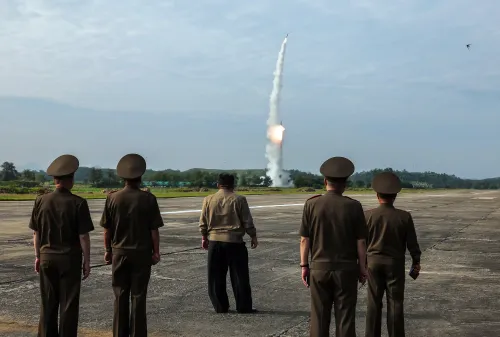Did India Just Win a Technological Battle During Operation Sindoor?

Synopsis
Key Takeaways
- Operation Sindoor validated India's defense transformation.
- India's indigenous weaponry outperformed foreign systems.
- The Make in India initiative is crucial for defense self-reliance.
- Pakistan's reliance on Chinese hardware hindered its military effectiveness.
- India's defense advancements may reshape regional security dynamics.
Washington/New Delhi, May 29 (NationPress) The swift, multidimensional military operation known as Operation Sindoor not only dismantled cross-border terrorism networks but also served as a comprehensive endorsement of India's defense evolution, stated a prominent American defense analyst on Thursday.
In his thorough examination titled 'India's Operation Sindoor: A Battlefield Verdict on Chinese Weapons — And India's Victory', urban warfare specialist John Spencer asserted that Operation Sindoor transcended a mere military initiative; it was a showcase of technological prowess, a market indicator, and a strategic framework.
Spencer noted, 'India demonstrated to the globe what self-reliance in contemporary warfare entails — and validated that Atmanirbhar Bharat is effective even under combat conditions.'
He continued, 'Operation Sindoor pitted India's homegrown weaponry against Chinese-equipped systems utilized by Pakistan. India not only achieved victory on the battlefield but also triumphed in the technology referendum. What transpired was not merely retaliation, but the strategic unveiling of a sovereign arsenal created under the dual doctrines of Make in India and Atmanirbhar Bharat.'
Spencer, who serves as the Chair of urban warfare studies at the Modern War Institute and Co-Director of the Urban Warfare Project, emphasized that 'Pakistan's reliance on proxies' was no match for 'India's sovereign capabilities' during Operation Sindoor, which obliterated terrorist infrastructure deep within Pakistan following the tragic April 22 Pahalgam terror attack.
'India operated as a sovereign entity — employing precision instruments it had designed, developed, and deployed with unparalleled battlefield control. In contrast, Pakistan acted as a proxy force, reliant on Chinese hardware that performed poorly under pressure.'
Spencer elaborated on how India's journey toward becoming a modern defense power commenced in 2014 with Prime Minister Narendra Modi's launch of the Make in India initiative.
The initiative's objective was apparent: to minimize reliance on foreign arms imports and cultivate a premier domestic defense industry.
'The policy spurred joint ventures, allowed foreign direct investment into defense up to 74%, and motivated both public and private sector manufacturers to produce advanced military hardware locally.'
Spencer praised Modi, noting how 'Atmanirbhar Bharat' evolved into a national security framework rather than merely an economic strategy, particularly following the dual shocks of the Covid-19 pandemic and the Galwan Valley confrontation with China.
'India implemented phased bans on critical defense imports, empowered the armed forces with emergency procurement capabilities, and heavily invested in indigenous research, design, and production.'
By 2025, India's domestic content in defense procurement had surged from 30% to 65%, with aspirations of reaching 90% by the end of the decade.
Spencer asserted that India's new doctrine was rigorously tested on April 22 when militants sponsored by Pakistan killed 26 Indian civilians in a terror attack in Jammu and Kashmir's Baisaran Valley.
He provided an in-depth analysis of how India's arsenal overwhelmed Pakistan.
The BrahMos supersonic cruise missiles, jointly developed with Russia and now predominantly manufactured in India, were deployed against high-value targets such as radar installations and fortified bunkers.
'Its speed and minimal radar signature make it nearly impossible to intercept.'
The Akash surface-to-air missile, developed by the Defence Research and Development Organisation (DRDO), facilitated coordinated responses to various airborne threats, including drones and aircraft.
Additionally, India's first domestically produced anti-radiation missile, Rudram-1, was utilized to neutralize Pakistani ground-based radars.
Spencer highlighted how the Netra Airborne Early Warning and Control (AEW&C) system, also developed by DRDO, enabled real-time tracking of hostile aircraft and missiles, directing Indian jets for deep-strike operations.
'Its effectiveness was clear when Pakistan's Swedish Saab 2000 AEW&C was destroyed by a long-range missile.'
India also deployed Harop and SkyStriker drones — precision-guided 'Kamikaze' munitions capable of targeting enemy positions with minimal collateral damage.
Meanwhile, India's Drone Detect, Deter, and Destroy System (D4S) neutralized numerous Chinese-manufactured Pakistani drones, marking a transition from reactive air defense to proactive electronic warfare superiority.
Imported from the US yet customized for Indian mountain warfare, the M777 Ultra-Light Howitzer was employed with Excalibur precision-guided munitions for strikes against terrorist camps while maintaining the integrity of the LoC.
Upgraded T-72s were stationed along the LoC for surveillance roles, while the new Zorawar light tank, optimized for high-altitude conditions, is under development, illustrating India's ongoing commitment to enhancing mobility and firepower in challenging Himalayan landscapes.
Spencer also discussed the involvement of India's most advanced fighter jets during Operation Sindoor, with the Rafales executing precise strikes using SCALP long-range cruise missiles against fortified enemy positions.
Additionally, the Su-30MKI and Mirage 2000 contributed to air superiority, launching multiple strike packages and ensuring airspace dominance.
These aircraft operated under the protective coverage of the Netra AEW&C system, which provided critical tracking of enemy aircraft. Rudram anti-radiation missiles were employed in Suppression of Enemy Air Defenses (SEAD) missions to disable enemy radar.
In contrast, Spencer provided a comprehensive analysis of Pakistan's strategic shortcomings and the failures of Chinese systems.
During Operation Sindoor, the JF-17 Thunder aircraft, produced in Pakistan but designed by China's AVIC, were unable to achieve air superiority against Indian forces.
'Their limited payload and outdated radar capabilities were evident under the pressure from India's electronic warfare.'
With the F-16 Fighting Falcons sidelined due to US restrictions, Pakistan lacked a credible frontline air dominance asset.
'Chinese imitations of Russia's S-300 and Buk systems, namely the HQ-9 and HQ-16, were deployed to counter Indian strikes but failed under India's jamming efforts.'
These systems were easily bypassed by BrahMos and loitering drones, exposing significant vulnerabilities.
The LY-80 and FM-90 air defense systems, also of Chinese origin, could not detect or intercept India's low-flying drones.
This compelled Pakistan to rely on passive air defense instead of any credible kinetic response.
Pakistani UAVs, the CH-4s, were frequently downed or jammed, showcasing their inadequacy in environments dominated by India's D4S system.
'Reports surfaced that Turkish drone operators had to be brought in to manage UAVs, highlighting both equipment and personnel dependencies.'
Pakistan's essential airborne early warning platform, the Swedish Saab 2000 AEW&C, was eliminated, likely by an S-400 system, severely impacting Pakistan's air awareness.
'By the conclusion of the operation, Pakistan had lost critical radar facilities, its leading AEW&C aircraft, numerous drones, and its capability to contest Indian airspace.'
Spencer also noted the surge in India's defense stocks in May, reflecting growing investor confidence, while Chinese defense stocks witnessed a notable decline following Operation Sindoor.









